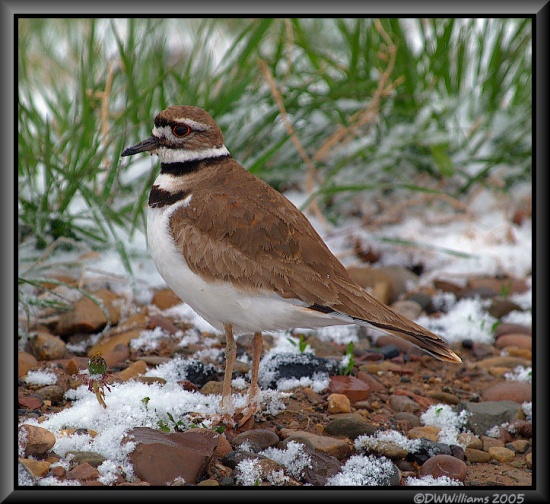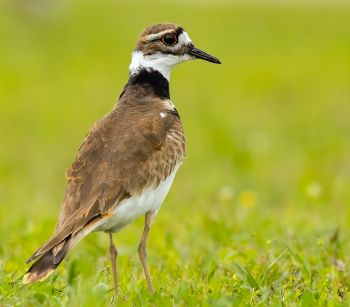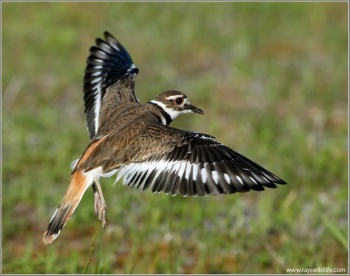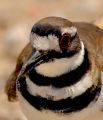(→External Links: Multiple GSearches combined) |
|||
| (18 intermediate revisions by 3 users not shown) | |||
| Line 1: | Line 1: | ||
| + | [[Image:Killdeer.jpg|thumb|550px|right|Photo © by {{user|BigSkyBirds|BigSkyBirds}}<br />South of Great Falls, [[Montana]], [[USA]], April 2005]] | ||
;[[:Category:Charadrius|Charadrius]] vociferus | ;[[:Category:Charadrius|Charadrius]] vociferus | ||
| − | |||
==Identification== | ==Identification== | ||
| + | |||
| + | 20–28 cm (7¾-11 in)<br /> | ||
The only North American plover with a double black breast band. | The only North American plover with a double black breast band. | ||
| + | *Orange-brown rump and upper tail | ||
| + | |||
==Distribution== | ==Distribution== | ||
| − | [[North America]], [[ | + | [[File:Killdeer_CVvociferus_SJ.jpg|thumb|350px|right|'' C. v. vociferous ''<br />Photo © by {{user|Stanley+Jones|Stanley Jones}}<br />Brazos County, [[Texas]], [[USA]], 09 April 2021]] |
| + | Breeds throughout much of [[North America]] as far north as south [[Alaska]] and central [[Canada]] and winters in Atlantic and Pacific states and in the southernn [[USA]] southwards. In the east breeds north to [[Quebec]] and [[Newfoundland]] and occasionally taken north to Newfoundland in late autumn and winter by storms on the Atlantic coast. This is the origin of transatlantic stragglers. | ||
| + | |||
| + | Vagrants recorded in [[Iceland]], [[Faroes]] and [[British Isles]], south to [[Spain]], [[Portugal]] and the [[Azores]] and east to [[Hungary]] and [[Romania]]. Most records come from the [[British Isles]] (c.47 British records) in late autumn, winter and early spring and although well-scattered the majority are in the south-west and especially on [[Scilly]]. | ||
| + | |||
==Taxonomy== | ==Taxonomy== | ||
| − | ====Subspecies<sup>[[#References|1]]</sup> | + | ====Subspecies==== |
| − | *''C. v. vociferus'' - Canada, US and Mexico; winters to | + | [[Image:DSC 43501099w.jpg|thumb|350px|right|Photo © by {{user|raymondjbarlow|raymondjbarlow}}<br />Fifty Point Conservation Area, Stoney Creek, [[Ontario]], May 2007]] |
| − | *''C. v. ternominatus'' - Greater Antilles | + | There are 3 subspecies<sup>[[#References|1]]</sup>: |
| − | *''C. v. peruvianus'' - Peru and | + | *''C. v. vociferus'' - [[Canada]], [[US]] and [[Mexico]]; winters to north-western [[South America]] |
| + | *''C. v. ternominatus'' - [[Greater Antilles]] | ||
| + | *''C. v. peruvianus'' - [[Peru]] and north-western [[Chile]] | ||
==Habitat== | ==Habitat== | ||
| + | |||
Open grassy land including pastures, lawns, airfields and golf courses. Also mudflats, along shorelines and beside gravel-pits, especially in winter. | Open grassy land including pastures, lawns, airfields and golf courses. Also mudflats, along shorelines and beside gravel-pits, especially in winter. | ||
==Behaviour== | ==Behaviour== | ||
Notorious for its "broken-wing" display to distract predators from nests and young. | Notorious for its "broken-wing" display to distract predators from nests and young. | ||
| + | ====Diet==== | ||
| + | Their diet consists almost entirely of insects, particularly beetles and flies; with the addition of grasshoppers, crickets, caterpillars, dragonflies, millipedes, worms, snail and, spiders. | ||
| + | ==Gallery== | ||
| + | Click on photo for larger image | ||
| + | <gallery> | ||
| + | File:Killdeer_For-Head-Detail_STJN.jpg|Photo © by {{user|Stanley+Jones|Stanley Jones}}<br />Brazos County, [[Texas]], [[USA]], 29 May 2021 | ||
| + | File:Killdeer_Chick-Juvenile_VCTR.jpg|Chick - Juvenile<br />Photo © by {{user|Victor+Vector|Victor Vector}}<br />Mojave Narrows Regional Park, [[California]], [[USA]], 29 April 2021 | ||
| + | File:Image1445.jpg|Display<br />Photo © by {{user|Kadawe|Kadawe}}<br />Newbury, [[Massachusetts]], March 2016 | ||
| + | </gallery> | ||
==References== | ==References== | ||
| − | # | + | #{{Ref-Clements6thAug19}}#Wiersma, P., Kirwan, G.M. & Boesman, P. (2019). Killdeer (Charadrius vociferus). In: del Hoyo, J., Elliott, A., Sargatal, J., Christie, D.A. & de Juana, E. (eds.). Handbook of the Birds of the World Alive. Lynx Edicions, Barcelona. (retrieved from https://www.hbw.com/node/53827 on 18 August 2019). |
| + | {{ref}} | ||
==External Links== | ==External Links== | ||
| − | {{GSearch|Charadrius | + | {{GSearch|"Charadrius vociferus" {{!}} "Killdeer"}} |
| − | [[Category:Birds]][[Category:Charadrius | + | {{GS-checked}}1 |
| + | <br /> | ||
| + | <br /> | ||
| + | |||
| + | [[Category:Birds]][[Category:Charadrius]] | ||
Latest revision as of 20:48, 28 January 2023
- Charadrius vociferus
Identification
20–28 cm (7¾-11 in)
The only North American plover with a double black breast band.
- Orange-brown rump and upper tail
Distribution
Breeds throughout much of North America as far north as south Alaska and central Canada and winters in Atlantic and Pacific states and in the southernn USA southwards. In the east breeds north to Quebec and Newfoundland and occasionally taken north to Newfoundland in late autumn and winter by storms on the Atlantic coast. This is the origin of transatlantic stragglers.
Vagrants recorded in Iceland, Faroes and British Isles, south to Spain, Portugal and the Azores and east to Hungary and Romania. Most records come from the British Isles (c.47 British records) in late autumn, winter and early spring and although well-scattered the majority are in the south-west and especially on Scilly.
Taxonomy
Subspecies
There are 3 subspecies1:
- C. v. vociferus - Canada, US and Mexico; winters to north-western South America
- C. v. ternominatus - Greater Antilles
- C. v. peruvianus - Peru and north-western Chile
Habitat
Open grassy land including pastures, lawns, airfields and golf courses. Also mudflats, along shorelines and beside gravel-pits, especially in winter.
Behaviour
Notorious for its "broken-wing" display to distract predators from nests and young.
Diet
Their diet consists almost entirely of insects, particularly beetles and flies; with the addition of grasshoppers, crickets, caterpillars, dragonflies, millipedes, worms, snail and, spiders.
Gallery
Click on photo for larger image
Photo © by Stanley Jones
Brazos County, Texas, USA, 29 May 2021Chick - Juvenile
Photo © by Victor Vector
Mojave Narrows Regional Park, California, USA, 29 April 2021Display
Photo © by Kadawe
Newbury, Massachusetts, March 2016
References
- Clements, J. F., T. S. Schulenberg, M. J. Iliff, S. M. Billerman, T. A. Fredericks, B. L. Sullivan, and C. L. Wood. 2019. The eBird/Clements Checklist of Birds of the World: v2019. Downloaded from http://www.birds.cornell.edu/clementschecklist/download/
- Wiersma, P., Kirwan, G.M. & Boesman, P. (2019). Killdeer (Charadrius vociferus). In: del Hoyo, J., Elliott, A., Sargatal, J., Christie, D.A. & de Juana, E. (eds.). Handbook of the Birds of the World Alive. Lynx Edicions, Barcelona. (retrieved from https://www.hbw.com/node/53827 on 18 August 2019).
Recommended Citation
- BirdForum Opus contributors. (2025) Killdeer. In: BirdForum, the forum for wild birds and birding. Retrieved 11 May 2025 from https://www.birdforum.net/opus/Killdeer
External Links
GSearch checked for 2020 platform.1









